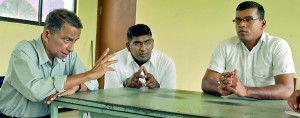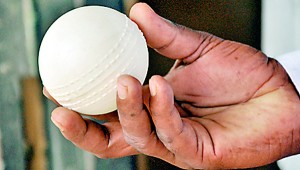Thanks to the national cricketers VH had the bat and handle
View(s):By Naushad Amit
The visually handicapped cricketers of Sri Lanka or the country’s blind cricketers as they are easily known, achieved a somewhat

Rienzie Benedict (L), Jagath Rajapakshe (C) and skipper Chandana Sooriyarachchi (R) explaining hardships ‘blind cricket’ has faced today. On right a ball used for ‘blind cricket’. - Pics by Amila Gamage
extraordinary feat that would undoubtedly open the eyes of many. Taking part in the inaugural World Twenty20 World Championship for blind cricketers, Sri Lanka finished third surpassing their goal which was to reach the semi-final stage.
This development has impelled the officials of Sri Lanka Cricket Association of the Visually Handicapped (SLCAVH) to continue its appeal to be affiliated to the powerful Sri Lanka Cricket. This was revealed by the president of SLCAVH, Rienzie Benedict, who also said that this has been a continuous plead from 1998, the year it was inaugurated but turned out to be a futile ever since.
“Other than a few good gestures by coaching and counselling, the responses have been negative from the SLC. In countries like Pakistan, South Africa and England, their main bodies are the caretakers of blind cricket. But in other countries it’s not the same. With our achievements in Bangalore at the inaugural Twenty20 WC, we are planning positively on the development and we seek the support of SLC for this. We hope this time SLC would respond positively,” Benedict stressed.
For many a Sri Lankan the above chapter would be just another news item, especially in a world where there are world championships at all forms. But only a handful knows that blind cricket was innovated in 1922 by two Australian factory workers who lost their vision due to some reason. But they have already witnessed the traditional form of cricket to come out with a special version where a tin filled with stones was used as a ball at the beginning.
 What makes blind cricket different from its conventional mode is the actions the bowlers and batsmen have to adopt dissimilar actions. The ball is made out of hard plastic with jingles placed in it and weighs 80 grams while the bat if similar to what is used around the world. Bowlers must use an underarm action while batsmen play shots similar to sweeps.
What makes blind cricket different from its conventional mode is the actions the bowlers and batsmen have to adopt dissimilar actions. The ball is made out of hard plastic with jingles placed in it and weighs 80 grams while the bat if similar to what is used around the world. Bowlers must use an underarm action while batsmen play shots similar to sweeps.
According to information provided by Benedict a team, be it at domestic or international level, should field four each of total blind (B1) and partly able to sight (B3) and three partly blind (B2) players. In addition players are subject to go through a certified medical examination conducted by the National Eye Hospital.
As at today, blind cricket has moved forward in most test playing nations but according to Chandana Sooriyarachchi, the captain, Sri Lanka is still stuck between the twilight zone, not knowing how to move forward with so many setbacks in their backyard. Yet with many trouble, these ‘blind cricketers’ have managed to bring colour to Sri Lanka, imparting the message of true girt, without proper technical or infrastructure support in their possession.
“We knew four months in advance of a Twenty20 WC for us (visually handicapped) is to be held but for us to make preparations, we simply had nothing. Our controlling body appealed to many establishments but the responses were very poor. But it was during the last 10 days, we got the good news that things have started to work out positively on our matter and we could get ready for the competition,” Sooriyarachchi revealed.
The estimated expenditure of the Sri Lankan blind cricketers for the whole competition was somewhere around rupees 1.2 million. With the SLCAVH playing a leading role in negotiating with top contributors, the sum however became a reachable target. Not knowing the real picture behind of a tournament of this magnitude, apparently the Sri Lankan contingent exceeded the estimated budget by rupees 200,000 which was however recovered by grants from supporters. In addition national cricketers contributed the blind counterparts in many ways. TM Dilshan took the trouble to provide five playing kits each for all players while Mahela Jayawardene contributed with a sum of rupees 100,000. In addition come players in the national squad pooled to contribute rupees 100,000. Former national skipper Arjuna Ranatunga supplied four bats in addition to encouraging the players during the tournament while the hotel staff of Movenpick Bangalore, where the players stayed presented two bats.
To put things in the perfect frame, the performances of the Sri Lankan blind cricketers were above par, having won six from eight matches they played, losing twice to India. They beat South Africa, Nepal, Australia, England and West Indies while losing to the eventually champions in the semi-final stage. According to Jagath Rajapaksa, the treasurer of SLCAVH and the coach of the Sri Lankans who toured Bangalore for the Twenty20 WC, the locals had just a couple of practice sessions prior to their departure.
“The players reached this far with their inborn talent, and I strongly feel if they are well nurtured they can reach far ahead. We also need to provide these players with more facilities and support to bring out the best out of them. They lack turf wicket practice and for this tournament Wesley College was generous to provide us their facility at Campbell Park. Other than that, at the moment they have simply nothing except for a few bats. But the way they handled their games in Bangalore, I feel that they are ready to move on,” Rajapaksa stated.
Apart from skipper Chandana Sooriyarachchi, Ruwan Karunatilleke, Chandana Deshapriya, Dimuthu Perera, K.V.R. Jayaratne, Kalyan Kumar, Madushanka Vishwanath, Sulochana Gunawardena, Upul Sanjeewa, Madhuka Jayasinghe, Dinesh Matugama, Dimuthu Ravindra, Saman Kumara, D. Chaminda, Chaminda Pushpakumara, Kosala Herath and Nuwan Tharanga represented Sri Lanka at the Twenty20 WC. Sooriyarachchi, Ravindra and Kumara who man-of-the-match awards each while Deshapriya won the award twice during the tournament. The blind cricketers’ only hope is see all needs and aspects in place prior to the Asia Cup which will be played in India during April 2013.
Follow @timesonlinelk
comments powered by Disqus





















